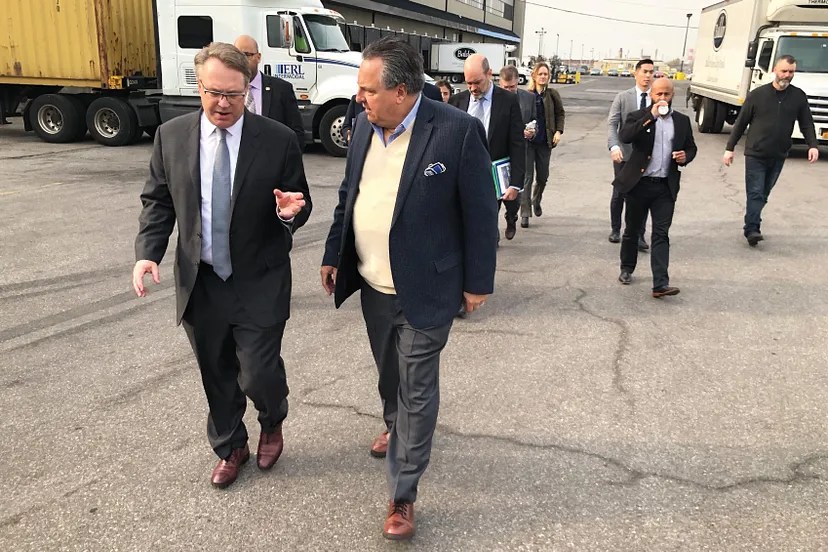
President Williams’ final regional visit of the year was to the Bronx, a borough that has made great strides since a period of declining population and rising crime that stretched from the 1970s into the 1980s. The progress of the last few decades notwithstanding, the Bronx still lags economically behind the rest of New York City, with the lowest median household income and highest poverty rate among the five boroughs. During his daylong visit, President Williams met with local nonprofits, businesses, and community leaders to discuss efforts to strengthen the local workforce, challenges facing small businesses, strategies to promote development without displacement, and the importance of anchor institutions and public-private partnerships.
Workforce Development
The Bronx is the poorest county in New York State, and according to the New York Fed’s New York City Credit Profile, 17 of the Bronx’s 25 zip codes are credit-constrained, meaning that they rank among the weakest nationwide on credit access, capacity, and payment histories. Against this backdrop, many parts of the Bronx have recently seen an economic renaissance. Local stakeholders are advancing these positive shifts with innovative partnerships and training opportunities focused on preparing Bronx residents for quality jobs. Bronx-based organizations such as Per Scholas and HERE to HERE are helping to build a workforce development ecosystem that brings together nonprofits, employers, educators, foundations, and others to help provide students and residents with training and networking opportunities necessary to secure long-term employment.
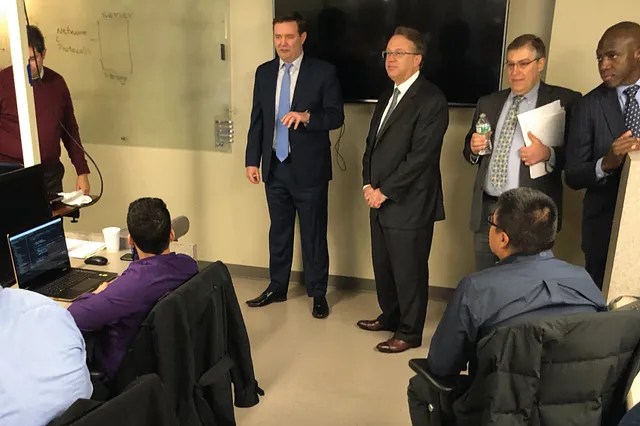
Per Scholas provides technology training for in-demand skills, and many program participants are low-income workers from the Bronx who have no formal training in IT. During a site visit to its Port Morris location, we met with current students in their 12-week employment and training program who are learning computer programming. The students emphasized the importance of working on tangible, real-life projects, and many were building their own applications with the guidance of a Per Scholas instructor. One example we saw was a scanner that identifies the ingredients in food products. Once students complete their training, Per Scholas works with local employers to place graduates at firms where they can begin careers as IT professionals. Initial research on the effectiveness of the Per Scholas program shows that it has had “large and growing impacts on employment and earnings” relative to a control group.
The New York Fed is a partner organization for Per Scholas and provides participants with workplace experience. This was the first year of the partnership, which placed six Per Scholas participants across the New York Fed for four months. The partnership will continue in 2019.
At HERE to HERE, a workforce development nonprofit located in the South Bronx, we met with high school students who participate in a program that connects them with employers to enhance career pathways. The program, called the Bronx Private Industry Council and led by HERE to HERE, is a coalition of Bronx-based companies committed to offering mentorships and paid internships. In addition to gaining professional skills and work experience, students can build social and professional networks — an opportunity that may not otherwise be available to them.
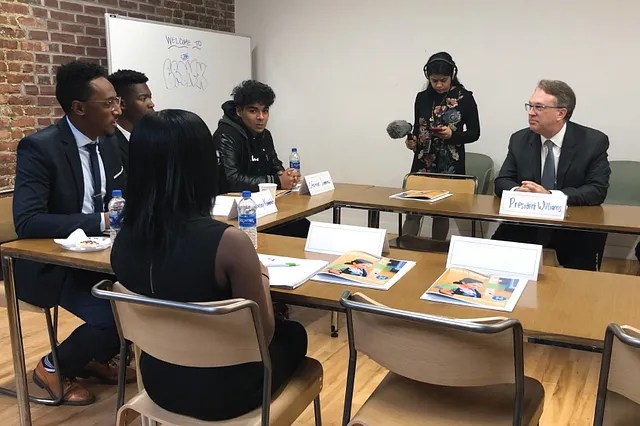
Both Per Scholas and HERE to HERE offer opportunities to build professional networks — which students said is important because simply acquiring new skills is not always enough to land a job. Meeting participants also emphasized the need for job fairs in their communities and for more learning opportunities for young adults.
In an interview with amNewYork during the visit, President Williams underscored the importance of these workforce development programs. He explained that when companies come to New York City offering high-paying jobs, there is an “opportunity for people — community colleges, nonprofits, employers — to really work on upskilling our labor force and helping people in the communities get the job skills, get the experience, whatever they need, in order to be competitive for these jobs.”
Small Business Challenges
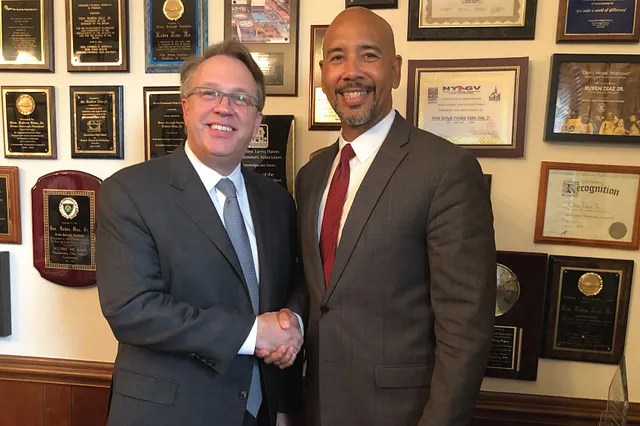
At many of our meetings in the Bronx, we heard about an acute need among small businesses for better access to capital to meet start-up costs and to finance growth. We also met with leaders from the Bronx Overall Economic Development Corporation (BOEDC), which has worked with local entrepreneurs to provide businesses with needed capital while keeping loan delinquencies to a minimum. During our lunch meeting with Bronx Borough President Rubén Díaz Jr., he explained that local small businesses are dynamic and represent the borough’s unique culture and style. However, he emphasized that many Bronx entrepreneurs need more support to help their businesses thrive — especially when it comes to managing budgets and accessing financing opportunities.
According to various stakeholders, loan programs designed to assist small entrepreneurs and start-ups often have underwriting requirements, such as a minimum FICO credit score, that can be an especially difficult constraint in minority communities. Over one-third of Bronx residents are foreign born, with a large number from the Caribbean. Members of these communities have fewer linkages to the traditional credit economy and may lack an extensive credit history. Given the critical role of small businesses in driving U.S. job growth, the New York Fed has long focused on supporting them, through research (including the annual Small Business Credit Survey fielded with other regional Federal Reserve banks) and “access to capital” workshops.
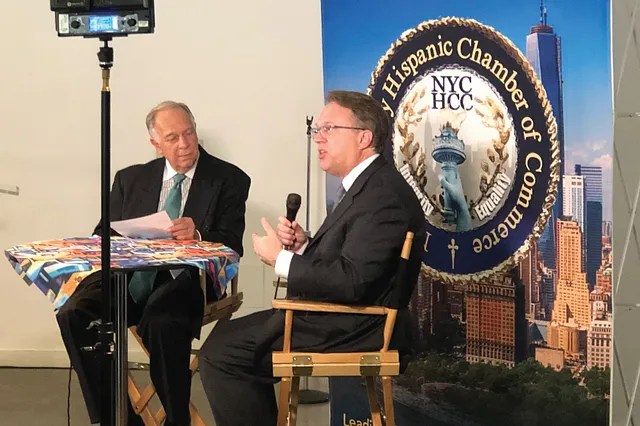
During a moderated conversation at the Bronx Museum of the Arts, President Williams highlighted how these observations align with what the New York Fed is seeing in its research and the role the Fed can play in supporting small businesses. “According to our survey, a lot of Latino-owned businesses tend to rely mostly on their own funds, from family, their own savings — which can obviously be very limiting in terms of growing a business,” he said. “So one thing we can do as the Federal Reserve is, we have this convening authority where we know a lot of the players — whether its local governments, banks, investors, nonprofits, and business leaders… to bring people together that perhaps weren’t even aware that these opportunities existed.”
Stakeholders stressed the importance of ensuring capital more easily “reaches the street” but with sufficient monitoring. They suggested that this could include additional touch points with borrowers, such as business classes, marketing, and technical assistance — services many small business advocacy organizations are best equipped to provide.
Equitable Growth
A top concern of many stakeholders across the borough is equitable growth — an issue that also came up during our visit to Brooklyn earlier this year. The Bronx hasn’t experienced the extreme growth levels seen in other parts of the city, and rents and home prices remain substantially lower on average than in other boroughs. However, residents in neighborhoods close to Manhattan and with extensive public transit links may be at increased risk of displacement. The median household income in the borough is just above $37,000, and 28% of individuals live below the poverty line, making this an understandable concern.
Stakeholders we met with highlighted the need for investment in the borough, but they also want to see development managed in a way that does not lead to displacement of residents. The Bronx has relatively affordable housing, yet homeownership rates are much lower compared to the rest of New York City. Anecdotal indications are that those displaced from the area either move in with friends and family — exacerbating issues with overcrowding — or move out of the region to areas such as Pennsylvania. Because neighborhoods can change quickly, community members and local leaders in the Bronx could consider implementing strategies to promote shared prosperity before market forces take root.
Anchor Institutions and Public-Private Partnerships
Throughout the trip, we frequently heard about the impact of anchor institutions on the borough. Anchor institutions are broadly defined as “entities having a large stake in a city, usually through a combination of internal missions and landownership. They… can be economic engines for cities and regions through their roles as real estate developers, employers, purchasers and magnets for complementary businesses or ‘knowledge workers’ and developers of human capital.” These typically include universities, hospitals, cultural institutions, and sometimes corporations.
In Hunts Point, we visited Baldor Specialty Foods. The company is headquartered in the Hunts Point Food Distribution Center, an area made up of more than 150 wholesalers that generate more than $3 billion in sales annually. Baldor has approximately 1,700 employees at this flagship location, and about 80% of them come from within New York City. Of those employees, approximately 80% are from the Bronx. While touring Baldor’s facilities, we learned about its history, operations, and efforts to provide training to prepare employees for their roles and encourage workforce retention. Baldor recently invested nearly $20 million to expand its operations in the Bronx and create additional jobs.
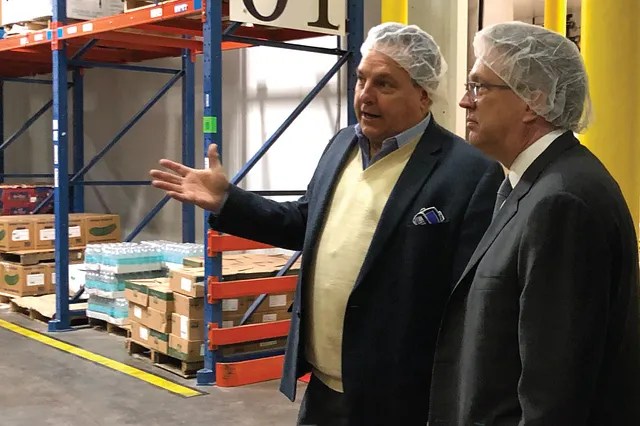
We also visited Montefiore Medical Center, in Norwood. The medical center is the borough’s largest employer, with about 44,000 workers — over half of whom live in the Bronx. Montefiore has a long history in the borough, having moved to the area in 1912 from Manhattan.
Like many others, the medical center is currently facing employment trends that can be seen more broadly. For example, Montefiore is finding it challenging to staff critical nursing and pharmacy roles, and to retain entry-level employees in housekeeping and food services. To better serve the borough and manage costs, Montefiore is moving toward an outpatient surgery and care model in certain facilities. Montefiore is also working with local partners on creative efforts such as providing healthcare to students in public schools across the Bronx through its school health program and is working with bodegas to promote healthy food options through its Healthy Store Initiative.
While the Bronx still faces its share of challenges, our engagements with these anchor institutions, community leaders, and workforce development programs showed that the borough is seeing positive growth and improved outcomes. As President Williams said at the Bronx Museum of the Arts, “What I’m hearing is excitement about the future. Excitement about what are the opportunities to make our communities stronger and healthier — to help small businesses grow, to get people the jobs and education and training they need… This is a time to really invest in our future, and really plan for our future. Because the economy goes up and down — and that’s just a fact of life — and right now it’s a really good time to be doing this.”
Next up
Our next regional visit will be to Puerto Rico and the U.S. Virgin Islands on March 28 and 29, 2019. For more about the purpose of the New York Fed’s regional visits and what we heard on earlier trips this year, see our posts on Brooklyn, Buffalo and Niagara Falls, and Puerto Rico and the U.S. Virgin Islands.
This article was originally published by the New York Fed on Medium.
The views expressed in this article are those of the contributing authors and do not necessarily reflect the position of the New York Fed or the Federal Reserve System.










